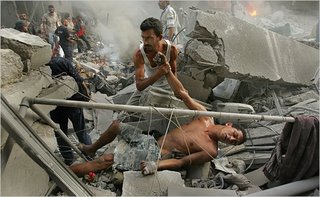The Lebanese Pietà photographer speaks

You will remember that this photo, dubbed the Lebanese Pietà, was one of a series in Fauxtography Affair during the recent Lebanese conflict. I posted on it here. Now the photographer, Tyler Hicks, has written an article explaining the circumstances surrounding the photo and how it came to end up with a incorrect caption implying that the man had died during an Israeli bombing.
The editorial process he describes I find believable, the sequence of events leading to the taking of the photo likewise. Some doubts do linger. He says that, at the sound of bombs and the sight of smoke nearby, he rushed to the scene from his hotel.I did not see any casualties on my arrival. I photographed the search effort, but otherwise there were no injured or dead visible.
Panic then spread as people feared that the Israeli jets were returning and it was in the rush to get away that the man fell and was injured.
Notice that: he could see no dead or even injured, which suggests that the buildings had been abandoned. This would make sense. The inhabitants would know that Hezbollah buildings were the targets, and that the Israelis probably knew which ones were Hezbollah. Moreover, the Isaelis dropped leaflets telling inhabitants at risk thanks to their neighbours that they should leave.
In a sense, therefore, we could this as an example of the Israeli effort to target as precisely as possible the immediate enemy and spare civilian (whatever that means in this context) casualties.
But have a look at the caption that Tyler Hicks himself wrote and that then got lost: TYRE, LEBANON. WEDNESDAY, JULY 26, 2006: Israeli aircraft struck and destroyed two buildings in downtown Tyre, Lebanon Wednesday evening. As people searched through the burning remains, aircraft again could be heard overhead, panicking the people that a second strike was coming. This man fell and was injured in the panic to flee the scene. He is helped by another man, and carried to an ambulance. (Photo: Tyler Hicks/The New York Times)
Firstly, in his own account, Hicks does not say if there really were Israeli jets the second time, just that people started running because they thought there were. Secondly, while it is true that the original caption does no more than give the same bare details as the fuller account in his article, the impression is that of senseless destruction. The story the photograph tells is that of Israeli jets bombing residential buildings. Why were they doing such a thing? No word. We do not see any dead bodies, but we are not told that there weren't any to see, and that is a most significant fact. It would change the entire tone of the image; the rhetoric of outrage and/or pathos would be considerably muted. That the message in the caption was distorted by some sub-editor towards a more overtly homicidal one is not surprising because it is implicit in the lack of context for the photo itself. And is it not also what a sub-editor of the New York Times would be inclined to think, in any case? Doesn't it fit the standard narrative?
Just one last point. It is just too beautiful. That pose is so precisely one that will speak loud to European sensitivities trained on crucifixions and depositions. I am not saying that the pose necessarily indicates that the photo is 'posed', but does life really deal in such perfection? Pietà is right. The lines of force are so wonderfully balanced - the vigour of the rescuer versus the docility of the prone body (it is almost an equilateral triangle), connected by the injured man's right arm which borrows strength by following the line of the rescuer's body, but evokes pathos with the limpness of the hand. Bloody masterful, I say. Check out how Michelangelo does the same thing with the body angles. Here too, concentration is focussed on the limp hand. 

1 comment:
I still say "bluff". And all that discussion ref. the sanctity of art on 'lightstalkers' is nauseous when you consider the potential impact of said 'art' on flesh (infinitely more sacred) once it is released and runs riot. Let's all shout "fire!" in a crowded theatre, why don't we?
Post a Comment